In my previous two posts (part 1, part 2) I have outlined the two routes offered by the Building Regulations 2010 Approved Document B (Vol. 2) at B4 (‘External Fire Spread’) to meet the statutory requirement that:
The external walls of the building shall adequately resist the spread of fire over the walls…
The first route, also sometimes called Option 1, or the ‘linear option’, is to satisfy the requirements of paragraphs 12.6 to 12.9. With regard to the fire properties of materials used in cladding systems for buildings over 18m in height, the requirements are in brief:
a) 12.6. External surfaces should be UK Class 0 OR European Class B or better. The relevant UK tests are BS 476-7 and BS 476-6. The European tests are EN ISO 11925-2 and EN 13823. All four tests are surface tests.
b) 12.7 Insulation products should be of ‘limited combustibility’. They should pass EITHER the BS 476-11 750º C furnace test OR the EN ISO 1182 750º C furnace test OR the EN ISO 1716 calorific test. These are combustibility tests.
The second route, also sometimes called Option 2, is for the entire cladding system to pass a large-scale test to BS 8414.
I will now describe the fire properties of the main two components used in the cladding system at Grenfell Tower, and discuss whether they could satisfy the Approved Document B4 requirements, through either of these two routes.
Celotex RS5000
Celotex give the following description of the fire performance of RS5000 in its Specification Guide at p. 5:
Celotex inform the potential purchasers of their product that:
- it has Class 0 surface performance having achieved the necessary results in BS 476-7 and BS 476-6;
- it has been successfully tested in one particular configuration to BS 8414-2.
It is noteworthy that Celotex do not tell us the product’s EN 13501-1 classification. It seems probable that the reason they do not do so is that it does not have a high European class. Generally, UK Class 0 corresponds to EN 13501-1 Class B, but as stated in the notes in the following extract from a correspondence table, this cannot be assumed without testing:
That RS5000’s European Class is lower than A2 becomes almost explicit in Celotex’s ‘Rainscreen Cladding Compliance Guide‘ for buildings over 18m:
They say first that the document provides guidance on how to comply with Approved Document B Vol. 2 (AD B2), and then say that it explains how to take an ‘alternative route’ to compliance with AD B2:
They helpfully quote from AD B2 at 12.5 to show the two routes:
Thereafter they make no further mention of Option 1, but discuss only what they called the ‘alternative route’ of testing to BS 8414. It is hardly conceivable that they would not describe Option 1 if it was open with this product.
As I explained in part 1 at the section on limited combustibility, it is in any case impossible, because of the physical properties of polyisocyanurate, for a PIR insulation board to achieve an A2 rating, and so for Option 1 to be open to it.
the alternative route via BS 8414
Despite it being a combustible product, Celotex have successfully tested to BS 8414 a cladding system which included RS5000 insulation boards. By success is meant that the performance criterion of BR 135 was satisfied (see part 2 for details). The system was fixed to a structural steel frame and was tested to BS 8414-2 rather than to BS 8414-1, which is the test used for systems applied to the masonry face of a building as at Grenfell Tower.
The system tested is described in the extract from the Specification Guide above, and also in the following extract from the Compliance Guide (SFS stands for Steel Framing System):
One key point for our purposes is that the cladding panels were made of fibre cement. A drawing on the same page identifies them as ‘Marley Eternit Natura panels’:
Marley Eternit cladding panels are EN 13501-1 Class A2, as is shown by a Certificate issued by the BBA in 2006:
It is easy to see that a system with cladding panels of limited combustibility will likely have much better fire performance than one with the same insulation boards but combustible panels.
Local Authority Building Control (LABC) issued a Certificate for the Celotex RS5000 boards in August 2014:
LABC state explicitly that the RS5000 boards do not meet the limited combustibility criteria of AD B2 paragraph 12.7 I believe ’82’ is a misprint for ‘B2’. I do not understand why they refer to the product as polyurethane (PUR), when it is made from polyisocyanurate (PIR). PIR is however a thermosetting (rather than thermoplastic) insulating material, and with similar chemistry to PUR, and I suspect this is just a slip. Alternatively, it may be that the term polyurethane can be used to include PIR.
Thermosetting insulants (rigid polyurethane foam boards) do not meet the limited combustibility requirements of AD 82 [sic., read B2] and so should not be accepted as meeting AD 82 [B2] paragraph 12.7.
However, they may be acceptable for use in buildings above 18m if they are included in a cladding system that is tested to BS 8414 according to the criterion of BS 135:
The certificate contains explicit conditions:
While Celotex RS5000 has been successfully tested to BS 8414-2, this classification is only valid for the system specification and the detailing contained in a BRE Classification Report:
Then this tested system is again specified:
To conclude then, Celotex RS5000 insulation boards can only be used on buildings above 18m as part of a specific cladding system which has been subjected to the large-scale BS 8414 test, and succeeded in meeting the criterion of BS 135.
The Celotex RS5000 promotional literature only mentions one such test, to BS 8414-2, as described above, with fibre cement panels. It seems highly unlikely that they would have failed to mention another successful test, to BS 8414-1, with ACM panels, if it had been conducted.
Reynobond PE
The purpose of the polyethylene core is to add ‘strength and rigidity’ to the panels:
In comparison with solid metal panels, composite panels can achieve the same stiffness at significantly lower cost: 1
On a European section of the web-site of Arconic, the manufacturer of Reynobond PE, is an information sheet for their aluminium panels entitled ‘Fire safety in high-rise buildings: Our fire solutions’:
The explanation it gives on European fire standards is seriously misleading. They claim that EN 13501-1 Class B products are ‘hardly combustible’:
Nothing could be further from the truth. In reality, there is no limit on the combustibility of Class B products, because they do not need to be subjected to the two combustibility tests, EN ISO 1182 (750° C furnace test) and EN ISO 1716 (calorific test). The true situation is laid out in Technical Information sheet TI-03 v1 from Exova Warringtonfire:
It can be seen, first, that whereas Arconic call Class A2 products ‘incombustible’, Warringtonfire say that they are of ‘limited combustibility’. Warringtonfire are correct, as can be seen from the distinction made between Classes A1 and A2 in EN 13501-1:2007 at A.4.2, page 44:
While Class A2 products do not ‘significantly contribute’ to a fully developed fire, Class A products do not contribute at all to such a fire, according to the standard.
The more important point, for our purposes here, is Warringtonfire’s table makes no claim about the combustibility of products of Class B and below. The reason can be seen from the right hand column which details the tests that have to be taken for each class. The two combustibility tests EN ISO 1182 and EN ISO 1716 are required only for Classes A1 and A2. The two tests required for Class B and below, EN 11925-2 (single-flame ignitability test) and EN 13823 (single burning item test), are surface performance tests.
a difference in kind
It may perhaps be natural from our experience with school grades and the like to expect that the difference between Class B and Class A2 will be only one of degree. We might be used to Class A1 representing, say, 80% performance and better, Class A2 70%, Class B 60% and so on. But the European fire classes do not represent a gradual gradation of this sort. On the contrary, Class A products are fundamentally different in kind to products of the lower classes.
A 1996 European Commission Decision (96/603/EC) listed in an Annex materials that would be designated as Class A (now A1) without even being tested:
The list includes mineral wool, glass, cement, concrete, ceramics and metals such as steel, copper, zinc, lead and aluminium. For example:
and:
When building fire temperatures exceed the melting point of aluminium and its alloys (600-660º C) , the metal may melt, but it does not burn, according to the Aluminium Federation.
In general, I think, these non-combustible products are inorganic, while organic products including woods and polymers burn easily. Ceramics, for example, can withstand temperatures of 1,000 – 1,600º C, while commercial grades of polyethylene melt at 120 – 180º C, according to Wikipedia. At temperatures of 350 – 600º C, most polymers decompose and ‘can provide a rich source of hydrocarbon fuel’: 2
In my last post I described a large-scale facade test to BS 8414 in which temperatures reached about 700º C in one case. In a fire at this temperature, most polymers will be completely consumed within a short length of time, while inorganic building materials will generally be completely untouched. Even aluminium will probably survive because of its high thermal conductivity, which allows heat to pass quickly from hot areas to cooler ones.
In the same way, all polymers will I think fail the BS 476-11 and EN ISO 1182 750º C furnace tests, while materials like glass, ceramic, concrete and so on would pass them. Again, all polymers will fail the EN ISO 1716 calorific value test. As I explained in my first post, Class A2 materials must have calorific value of no more than 3 MJ/kg, but polyethylene, for example, has a calorific value of up to 48 MJ/kg, about the same as that of gasoline, and sixteen times what is required. (EN 13501-1 specifies at 11.7.3 that for a non-homogenous product, each substantial component has to have calorific value ≤ 3 MJ/kg. The weight of the aluminium can therefore not be factored in, as I understand it. )
I am about to present evidence that Reynobond PE is EN 13501-1 Class B, just one grade away from the A2 required for limited combustibility. Please don’t let that make you suppose that it’s combustibility is only moderately greater than the A2 products. It could be anything, it’s combustibility has not been tested at all.
It follows that Arconic’s claim that Class B products are ‘hardly combustible’ has no basis in reality.
fire classifications
It is noteworthy that Arconic do not give any fire classification data for Reynobond PE in their ‘Fire Safety in High Buildings’ information sheet. In fact, the only mention of this product in the sheet is the following diagram advising against its use in even moderately high buildings, namely those over 10m:
Before moving on to other sources of information for Reynobond PE, the fire classifications for Reynobond FR (fire resistant) and Reynobond A2 (EN 13501-1 Class A2) on this sheet are instructive:
The rows represent:
I will present evidence below from a French test report that the core of Reynobond FR is polyethylene plus a mineral filler. The information above shows that the core of Reynobond FR is 70% mineral. If this is by volume then less than one third of the previous amount of polyethylene remains in the core. 3 But if I am right that the calorific value of Reynobond PE is sixteen times too high for an A2 rating, then the calorific value of Reynobond FR will still be five or six times too high, even with two thirds of the polyethylene removed.
Reynobond A2, on the other hand, is 90% mineral filler. Suppose that it also is polyethylene based. Then in this case, possibly 90% of the PE content has been removed. In that case, based on my crude back of the envelope calculation, the calorific value of the core would be 4.8 MJ/kg, only 1.6 times too high. It’s not too hard to envisage that by careful design the required criterion could have been met, given such a high level of mineral content. Possibly, for example, a different polymer is used, with lower calorific value.
BBA certification
The BBA (British Board of Agrément) issued an Agrément (Approval) Certificate to Alcoa Architectural Products for Reynobond cladding panels in 2008:
The panels are described as aluminium/polyethylene composite:
A ‘standard sample of the product’, presumably corresponding to Reynobond PE, achieved EN 13501-1 Class B-s2, d0, while Reynobond FR was classed as B-s1, d0:
Reynobond FR was tested to BS 476 parts 7 and 6, and achieved Class 0 (the highest):
Somewhat surprisingly, Reynobond PE was also apparently granted the UK Class 0 on the basis of these tests. Presumably, it was considered that since these are surface tests, and both products have the same aluminium facing, and since also the PE version passed the European surface tests, it was reasonable to expect that it would also pass the UK tests.
2011 cstb report
The CSTB (Centre Scientifique et Technique du Bâtiment) issued a Reaction to Fire Classification Report to Alcoa in 2011 for Reynobond® 55 PE cladding panels:
I do not know what the ’55’ stands for, but from the detailed description it would appear to be the same product with 0.5mm aluminium facings and a 3mm polyethylene core:
The only tests carried out were EN ISO 11925-2 (single-flame ignitability):
and EN 13823 (single burning item):
On the basis of these test results, the product was classed as EN 13501-1 Class B-s1, d0:
It thus received a better smoke production class (s1 rather than s2) than it had received from the BBA in 2008, but was otherwise the same. The TSP600s (Total Smoke Production in 600 seconds) was 47.7 m2, only marginally below the upper limit of 50 m2 for class s1, so the difference can easily be accounted for by normal variations in results or by improvements in the product over the previous three years. 4
No combustibility tests were taken, as far as the report shows, and thus no attempt was made to reach Class A2. There would be no point, since the core’s calorific value would be far to high to pass EN ISO 1716, and the melting point of the core far too high to pass the EN ISO 1182 750° C furnace test.
2011 cstb avis technique
The following year, the CSTB issued an Avis Technique (Technical Evaluation) for the same products, Reynobond 55 PE and Reynobond 55 FR:
The section on Fire Safety is of some interest because it gives calorific values as well as a reaction to fire classification. The translation is based on Google Translate, with some adjustments made with the help of a dictionary.
Safety in case of fire The system is compatible with regulatory requirements. The checks to be carried out (in particular for the so-called "C + D" rule, for buildings already in service) must take into account the following characteristics: Reynobond 55 PE panel The reaction-to-fire classification of the surface in use [that is, the tested surface, presumably] is M1 (in all plate thicknesses). The combustible mass of the sheets, which is reduced to [i.e. is accounted for only by] that of the polyethylene core, is equal to:
‘M1’ is a French fire classification, more or less equivalent to European Class B. 5
In the following table ‘Masse combustible’ seems to stand for ‘heat of combustion’. ‘combustible’ is an adjective, but can also be used as a substantive (a noun) to mean ‘fuel’. So perhaps ‘masse combustible’ means something like ‘fuel load’ and indeed it was translated this way on the bilingual Parks Canada web-site, with the reference being to the amount of heat released in a fire:
The units are in MegaJoules per square metre, so what is at issue is clearly the release of energy from the material when it is combusted. ‘Epaisseur panneau’ means ‘panel thickness’ and ‘epaisseur âme’ means ‘core thickness’:
PCS is Pouvoir Calorifique Supérieur, the Gross Calorific Value or Heat of Combustion. 10,500 Kcal/kg is equivalent to 43.9 MJ/kg, not far from the value of 48 MJ/kg I have been using, and within the normal range of polyethylenes. Taking the 4 mm panels with 3 mm core as an example, the heat release is 123 MJ for every square metre of material. The volume of a square metre of material of 3mm thickness is 0.003 m3, so the heat release per cubic metre is 123/0.003 = 41,000 MJ. If the density of the polythene is 950 kg/m2 then this gives a Heat of Combustion of 41,000/950 = 43.2 MJ/kg, which is close enough for these purposes. Or we could use the figures given to calculate the density of the polythene used as 41,000 ÷ 43.9 = 934 MJ/kg, which is well within the normal range for polythene.
There follows Fire Safety information about Reynobond FR:
Reynobond 55 FR panel Reaction to fire classification according to EN 13501-1: B-s1, d0. This classification is obtained with or without insulation classified A1 or A2-s1, d0. The combustible mass of the panels, which is reduced to [accounted for only by] that of the polyethylene core with added mineral fillers, is equal to:
Here is the evidence I mentioned above that Reynobond FR is polyethylene based. The table gives the Heat of Combustion for 4 mm panels as 76 MJ/m2, nearly 40% less than the value for Reynobond FR:
The calorific value for the core can be taken to be 43.9 ✕ 76 ÷ 123 = 27 MJ/kg, or still nine times the limit for materials of limited combustibility.
1997 warrington fire tests to bs 476 parts 6 & 7
Reynobond PE was tested to BS 476 parts 7 (surface spread of flame) and 6 (fire propagation) in 1997 and achieved the Class 0 certification (Part 7, Part 6, Summary):
The product was called Reynobond RB 160 Pe at that time, but seems to have had the same basic form as it does today:
The product was found to be of Class 0, as defined by the 1991 Building Regulations:
It can be seen that Reynobond PE is by no means a new product, and that it has long had the Class 0 certification.
Conclusions
Celotex RS5000 is an insulation product with EN 13501-1 Class lower than A2. It therefore cannot meet the requirements of AD B2, 12.7. It has been tested successfully to BS 8414, but only with one configuration so far as Celotex have made known, and that with Class A2 fibre cement panels. It is virtually certain that it has not been successfully tested with Class B ACM panels. Every indication is that its use on Grenfell Tower was in breach of the AD B2 guidance.
Reynobond PE ACM panels are EN 13501-1 Class B (and also UK Class 0) and so satisfy the conditions set in AD B2, 12.6. It should not be supposed that it is a safe product, however, for use on high buildings. The heat of combustion of its polyethylene core has been reported as 43.9 MJ/kg, nearly 15 times the maximum value set for products of limited combustibility, and higher than the value for fuel oil, as given in a spreadsheet held on the government’s web-site (2nd column; there are a thousand MJ in a GJ, and a thousand kilograms in a tonne, so the units are equivalent):
So far as I can see, it was rather as if Grenfell tower was clad with a 3mm layer of fuel oil, protected to a degree, but vulnerable to a major assault from a severe fire.
Andrew Chapman
Notes:
- White & Delichatsios, ‘Fire Hazards of Exterior Wall Assemblies Containing Combustible Components’, (Fire Research Research Foundation, June 2014) p. 4 ↩
- Mouritz & Gibson, ‘Fire Properties of Polymer Composite Materials’ (Springer, 2006) p. 7 ↩
- But if it’s by mass, rather more will remain, so far as I can see. ↩
- For those puzzled by the dimensions, the measurement in square metres seems to result from factoring in a measure of light obscuration expressed in reciprocal metres. See ISO 24473 at page 24. Link. ↩
- M0 products must have a calorific potential ≤ 2.508 MJ/kg. Therefore products of calorific potential between about 2.5 and 3 MJ/kg may be classed as EN 13501-1 Class B, but French M1. ↩
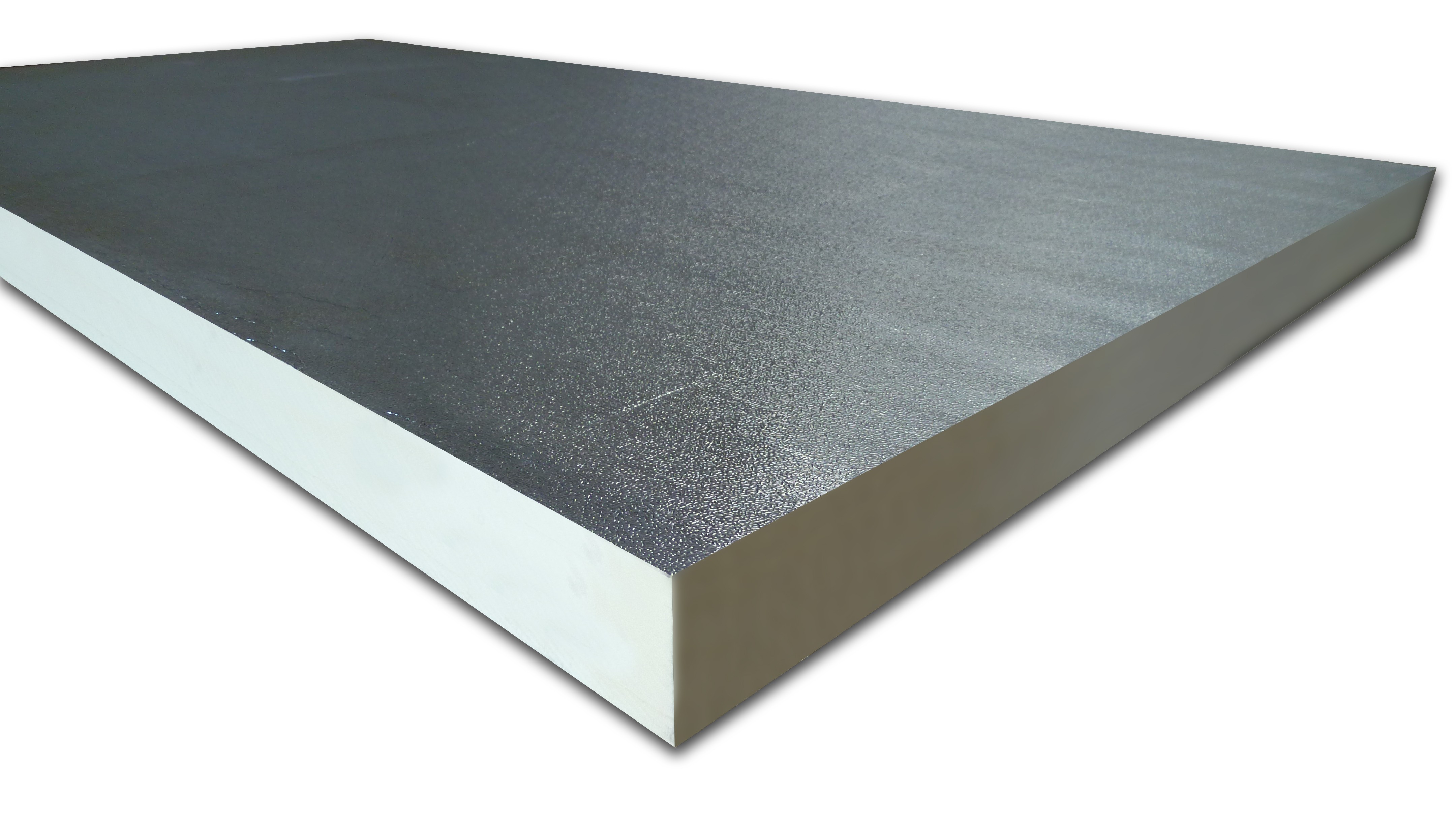
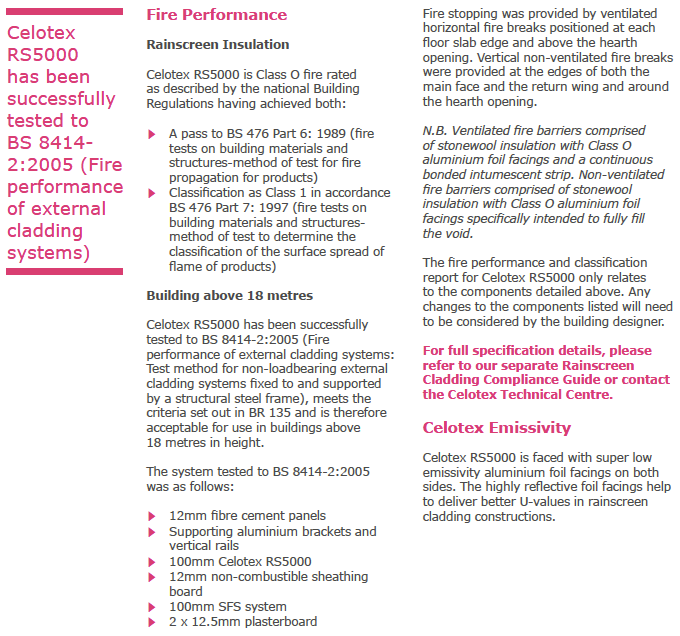

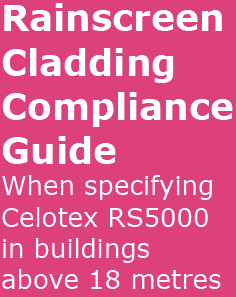
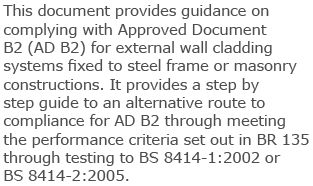


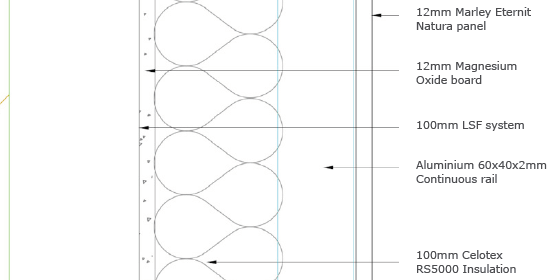

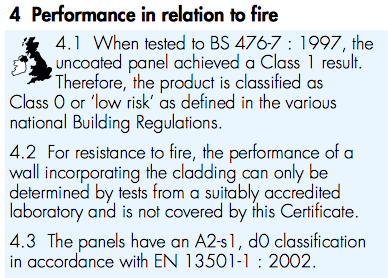

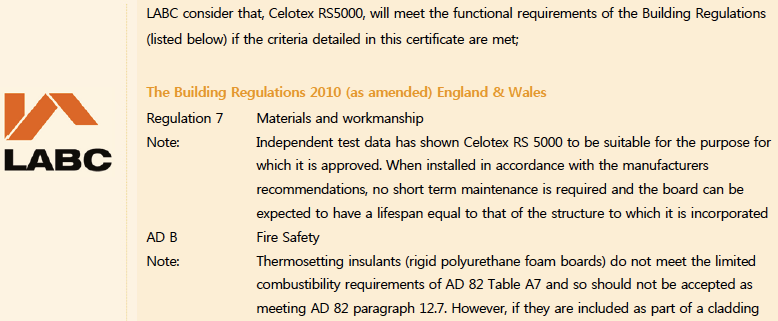



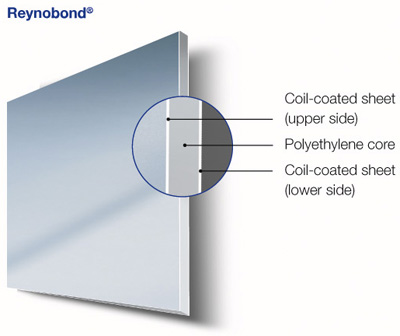



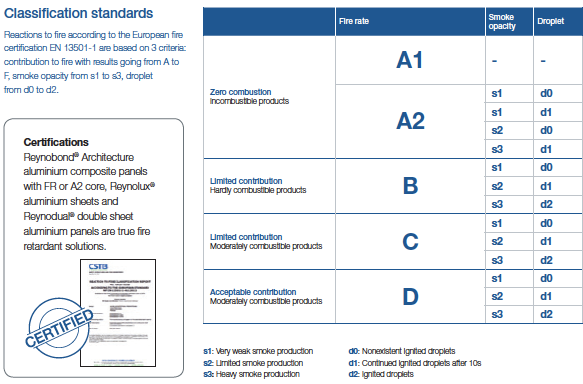
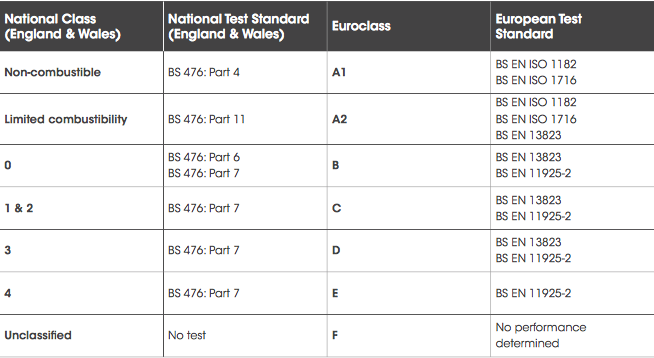



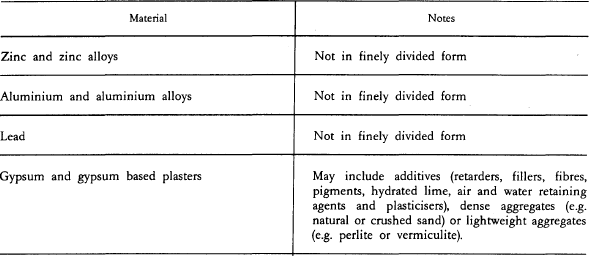

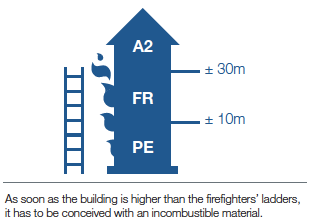
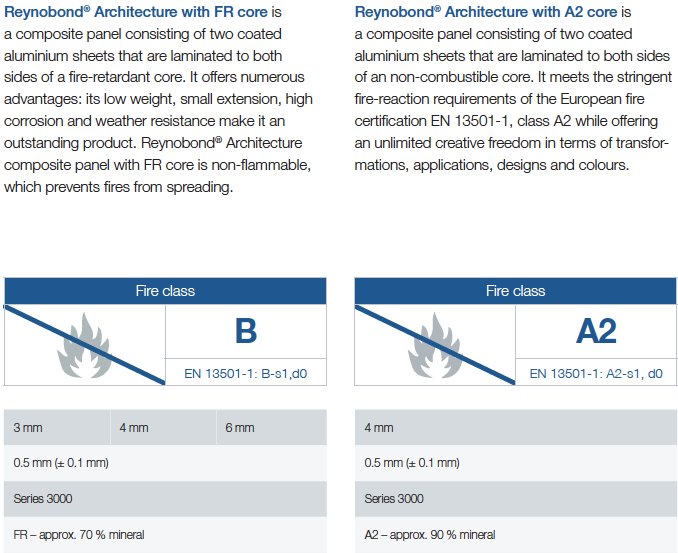
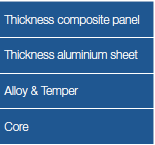







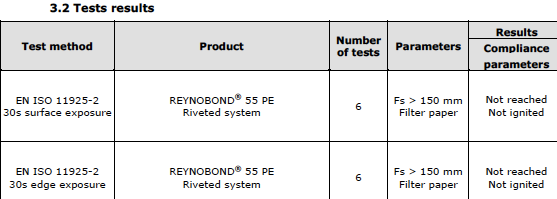


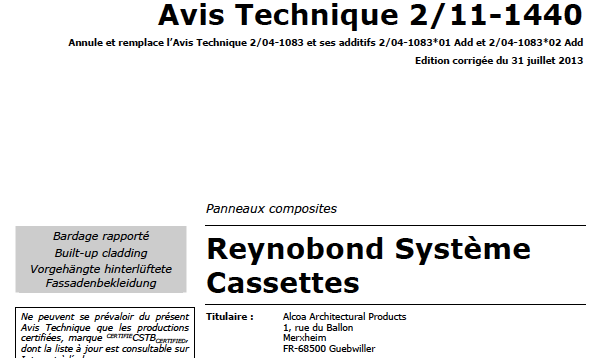
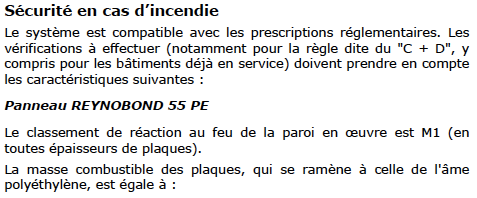








Thanks for the enormous effort you\’ve put into this, Andrew. Really interesting, with a horrifying conclusion
Andrew. Good man! Where is Parts 1 and 2? Can we please email to consolidate this into a simpler text? Regards, Ian Abley.
Thank you for the kind words. Part 1: http://theriveroflife.com/2017/06/23/grenfell-tower-was-the-cladding-legal-or-not-part-1/
Part 2: http://theriveroflife.com/2017/06/26/grenfell-tower-was-the-cladding-legal-or-not-part-2/
Andrew’
This 3 part blog has the best coverage I have seen of the technical issues and the plethora of standards relating to the fire performance of the cladding panels.
Whilst the evidence presented suggests that the Celotex insulation and the core of the Reynobond ACP facing would combust at the point of fire entry, there may be a (remote) possibility that if the panel had remained intact and the perimeter firebreaks had remained effective then the fire might have been contained within the panel – this would seem to be the basis of allowing a fire test of a representative assembly (as undertaken for a different Celotex based construction) to show compliance by performance. The specification and installation of the firebreaks on the Tower will be evident on the remaining cladding to the lower portion of the building .
The weaknesses of the \’fire test performance of an assembly\’ approach are a) the allowing of a desk based assessment of the fire performance of variations by a competent person – to avoid the the cost of more testing and b) the short period of time that the test requires the assembly to limit fire spread.
Thanks, Jim, for the kind words. Another drawback of the system fire test approach, it seems to me, is that the detailing will no doubt be done very carefully for the test, whereas we cannot be sure that it will always be done so well in real life.
With regard to the time period, the fire burns for half an hour in the test, which I would have thought should be just about enough time for the fire to be put out, even if it’s on an upper floor of a high building.
I agree with you about desktop testing, especially in the light of what has emerged about some of the systems that have been passed through desktop studies (even with FR ACM), apparently without any very closely related system being subject to a live fire test. But this weakness is not inherent to system testing, of course – the regulators are under no obligation to allow it at all.
Andrew
Yes, excellent job of digging. The information certainly does provide a good overview of the product properties. But be careful, Class 0 is a class used in Approved Document B, not derived from British standards. It refers to surface spread of flame – the surface – ref Diagram 40 and 12.6 in AD B. That isn’t the same as combustibility, which is bulk property of the whole material.
Thanks, Mike. I am at a bit of loss to understand why you think I might not be distinguishing properly between Class 0 and limited combustibility. I summarised the Linear Route above as follows:
‘the requirements are in brief:
a) 12.6. External surfaces should be UK Class 0 OR European Class B or better. The relevant UK tests are BS 476-7 and BS 476-6. The European tests are EN ISO 11925-2 and EN 13823. All four tests are surface tests.
b) 12.7 Insulation products should be of ‘limited combustibility’. They should pass EITHER the BS 476-11 750º C furnace test OR the EN ISO 1182 750º C furnace test OR the EN ISO 1716 calorific test. These are combustibility tests.’
Does that not make the distinction between the two very clear?
Andrew